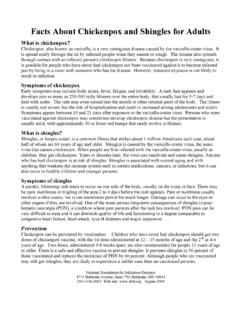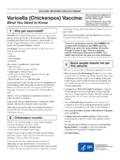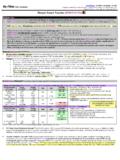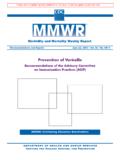Transcription of Assigned when a suspect is diagnosed with shingles …
1 ODH-IDCM varicella - zoster INFECTIONS Page 1/Section 3 Revised 1/2018 varicella - zoster INFECTIONS (Chickenpox and Herpes zoster [ shingles ]) REPORTING INFORMATION Class B: Report by the end of the next business day after the case or suspected case presents and/or a positive laboratory result to the local public health department where the patient resides. If patient residence is unknown, report to the local public health department in which the reporting health care provider or laboratory is located. Reporting Form(s) and/or Mechanism: Ohio Confidential Reportable Disease form (HEA 3334), Positive Laboratory Findings for Reportable Disease form (HEA 3333), the local health department via the Ohio Disease Reporting System (ODRS), or telephone. CDC varicella Surveillance Worksheet is available for use to assist in local health department disease investigation and contact tracing activities.
2 Information collected from the form should be entered into the Ohio Disease Reporting System (ODRS) and not sent to the Ohio Department of Health (ODH), unless otherwise requested. CDC varicella Death Investigation Worksheet is available to assist local health department death investigation. Information from the form should be entered into ODRS and sent to ODH. AGENT varicella - zoster virus (VZV), a member of the herpesvirus group. CASE DEFINITION (Chickenpox) Clinical Case Definition An illness with acute onset of diffuse (generalized) papulovesicular rash without other apparent cause. (A diagnosis of shingles does not meet clinical case definition). Laboratory Criteria for Diagnosis Isolation of varicella virus from a clinical specimen (vesicular fluid is best) or Direct fluorescent antibody (DFA) or Polymerase chain reaction (PCR) or Significant rise in serum varicella immunoglobulin G (IgG) antibody level by any standard serologic assay.
3 Case Classification Probable: A case that meets the clinical case definition, is not laboratory confirmed and is not epidemiologically linked to another probable or confirmed case. Confirmed: A case that meets the clinical case definition and is laboratory confirmed or is epidemiologically linked to a confirmed or probable case. Not a Case: This status will not generally be used when reporting a case, but may be used to reclassify a report if investigation revealed that it was not a case. Assigned when a suspect is diagnosed with shingles ( zoster , herpes zoster , HZ). Comments Two probable cases that are epidemiologically linked are considered confirmed, even in the absence of laboratory confirmation. ODH-IDCM varicella - zoster INFECTIONS Page 2/Section 3 Revised 1/2018 An outbreak of varicella is defined as the occurrence of five or more cases in a specific setting ( school) that are epidemiologically linked.
4 Cases should be considered part of an outbreak if they occur within at least one incubation period (21 days) of the previous case-patient, and surveillance should continue through two full incubation periods (42 days) after the rash onset of the last identified case-patient to ensure that the outbreak has ended. A cluster is defined as three to four cases. Clusters should also be reported and investigated in the same manner as an outbreak. In vaccinated persons who develop varicella >42 days after vaccination (breakthrough disease), the disease is almost always mild with <50 skin lesions and shorter duration of illness. The rash may also be atypical in appearance (maculopapular with few or no vesicles). Vaccinated persons who develop varicella within 7-42 days after vaccination are marked as not a case.
5 This is due to not knowing if the illness is due to wild-type or vaccine-type virus. Laboratory confirmation of cases of varicella is not routinely recommended. However, laboratory confirmation is recommended for at least one case in outbreak settings, for fatal cases and in other special circumstances. Evidence of immunity to varicella : Cases born in the United States before 1980 should be considered immune unless there is a note stating that the case was diagnosed by a physician as varicella (and not as shingles ). Note: For healthcare workers and pregnant women, birth before 1980 should not be considered evidence of immunity. SIGNS AND SYMPTOMS Primary infection with VZV results in chickenpox ( varicella ). Chickenpox infection may result in mild, atypical or inapparent disease.
6 In general, the disease causes a skin eruption which first appears maculopapular for a few hours and then becomes vesicular for 3-4 days and leaves a granular scar. Lesions are pruritic and tend to be more abundant on covered areas of the body. Lesions may also be seen on mucous membranes. A fever (up to 102 ) and malaise are also typical of chickenpox and adults may also experience headache and anorexia. Complications include infection of the skin lesions, pneumonia, arthritis, aseptic meningitis, thrombocytopenia, encephalitis and Reye syndrome. VZV persists in a latent form after the primary infection. Reactivation results in zoster ( shingles ), which is a local manifestation of recurrent, recrudescent or reactivated infection. Grouped vesicular lesions appear in the distribution of one to three sensory dermatomes, sometimes accompanied by pain localized to the area.
7 Systemic symptoms are few. zoster ( shingles ) occasionally may become generalized in immunocompromised patients, with lesions appearing outside the dermatomes and with visceral complications. DIAGNOSIS The virus may be isolated from fresh nonpurulent vesicular lesions during the first 3-4 days of the exanthematous illness. Herpesvirus particles can generally be seen by direct electron microscopic examination. ODH-IDCM varicella - zoster INFECTIONS Page 3/Section 3 Revised 1/2018 Culture Can be performed on vesicular fluid or biopsy specimens from sterile sites ( , CSF, joint fluid). VZV culture is less sensitive than PCR and can take several days to obtain a result. Rapid varicella zoster virus identification Because viral DNA persists after cessation of viral replication or after viral death, DFA or PCR may be positive when viral cultures are negative.
8 PCR is the method of choice for clinical diagnosis. Submit vesicular swabs or scrapings, scrapings from maculopapular lesions, scabs from crusted lesions, or biopsy tissue for testing. Serology The complement fixation test (CF) is best to determine diagnostic rises in titer. A four-fold or greater rise between acute and convalescent sera denotes a recent infection. Enzyme-Linked Immunosorbent Assay (EIA) is best for assessing immune status. One serologic specimen is adequate. Routine testing for varicella immunity following vaccination is not recommended. For general testing, specimens may be sent to the usual laboratory used by the physician or facility. If you want to submit a specimen associated with an outbreak to the Ohio Department of Health Laboratory for testing at the Vaccine-Preventable Disease (VPD) reference laboratory, please notify the ODH Bureau of Infectious Diseases VPD Epidemiology Program at (614) 995-5599 before shipping the specimen.
9 To submit a specimen for PCR testing, complete the Ohio Department of Health Laboratory Microbiology Specimen Submission Form found at: and the Wisconsin (WI) VPD Submission Form found at: EPIDEMIOLOGY Source Humans are the only source of infection. Occurrence Worldwide, most cases of chickenpox occur in children 5-10 years of age. Chickenpox is seen most often during the late winter and early spring. The vast majority of people contract the disease during childhood. Cases in adults are often severe. zoster ( shingles ) occurs mainly in older adults although there is some evidence that almost 10% of children being treated for a malignant neoplasm are prone to develop zoster ( shingles ). Intrauterine infection with VZV or chickenpox infection acquired before two years of age is also associated with zoster ( shingles ) at an early age.
10 zoster ( shingles ) is not seasonal. Mode of Transmission Transmission may be either direct or indirect. Persons with chickenpox spread the disease to others via direct contact with the drainage from lesions, droplets or airborne respiratory tract secretions. Vesicle fluid of patients with zoster ( shingles ) is infectious. Indirect transmission occurs through articles freshly soiled with discharge ODH-IDCM varicella - zoster INFECTIONS Page 4/Section 3 Revised 1/2018 from vesicles and mucous membranes of infected persons. Scabs of chickenpox lesions are not infective. While chickenpox is highly infective, patients with zoster ( shingles ) have a much lower rate of transmission. Susceptible contacts of either develop chickenpox. Introduction of a case of VZV into a household generally results in infection for almost all susceptible persons.







